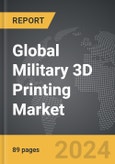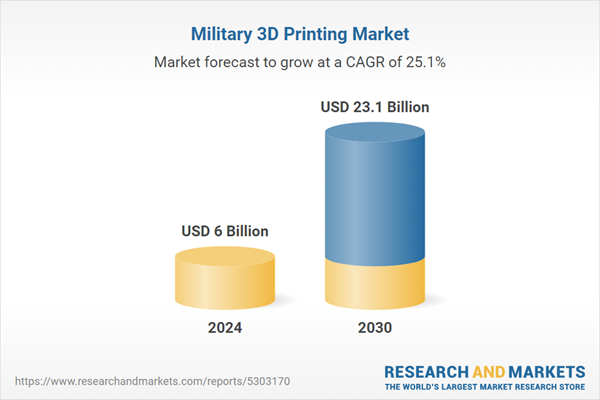The global market for Military 3D Printing was valued at US$6.0 Billion in 2024 and is projected to reach US$23.1 Billion by 2030, growing at a CAGR of 25.1% from 2024 to 2030. This comprehensive report provides an in-depth analysis of market trends, drivers, and forecasts, helping you make informed business decisions. The report includes the most recent global tariff developments and how they impact the Military 3D Printing market.
Segments: Component (Printer, Material, Software, Service); Platform (Airborne, Land, Naval, Space); Application (Functional Part Manufacturing, Tooling, Prototyping).
Geographic Regions/Countries: World; United States; Canada; Japan; China; Europe (France; Germany; Italy; United Kingdom; Spain; Russia; and Rest of Europe); Asia-Pacific (Australia; India; South Korea; and Rest of Asia-Pacific); Latin America (Argentina; Brazil; Mexico; and Rest of Latin America); Middle East (Iran; Israel; Saudi Arabia; United Arab Emirates; and Rest of Middle East); and Africa.
The analysts continuously track trade developments worldwide, drawing insights from leading global economists and over 200 industry and policy institutions, including think tanks, trade organizations, and national economic advisory bodies. This intelligence is integrated into forecasting models to provide timely, data-driven analysis of emerging risks and opportunities.
Global Military 3D Printing Market - Key Trends and Drivers Summarized
How Is Military 3D Printing Shaping Defense Manufacturing and Logistics?
Military 3D printing, also known as additive manufacturing, is transforming defense manufacturing by enabling the rapid production of complex parts and equipment with enhanced precision and reduced lead times. This technology allows military organizations to produce components on-demand, reducing reliance on traditional supply chains and enabling more flexible logistics in the field. 3D printing can be used to manufacture everything from spare parts for vehicles and aircraft to specialized equipment and tools for soldiers. The ability to print parts on-site, particularly in remote or combat environments, is one of the most significant advantages of military 3D printing. This capability reduces the need to transport large quantities of spare parts, lowering logistical costs and improving operational efficiency. In addition, 3D printing allows for the rapid prototyping and customization of military equipment, enabling the development of mission-specific tools and components.What Innovations Are Driving the Military 3D Printing Market?
Recent innovations in materials science and 3D printing technologies are enhancing the capabilities of military 3D printing. The development of high-strength, lightweight materials such as advanced polymers, composites, and metal alloys is enabling the production of durable and functional components for military applications. Additionally, advancements in multi-material printing allow for the creation of complex, multi-functional parts that combine different materials for improved performance. The integration of artificial intelligence (AI) and machine learning (ML) into 3D printing processes is also driving innovation. AI-powered systems can optimize the design and production of parts, reducing material waste and improving manufacturing efficiency. Moreover, 3D printing is being used to produce complex geometries that are difficult or impossible to create using traditional manufacturing methods, enabling the development of next-generation military equipment.How Do Market Segments Define the Growth of Military 3D Printing?
Materials used in military 3D printing include metals, polymers, and ceramics, with metals being the most widely used due to their strength and durability. Technologies used in military 3D printing include stereolithography (SLA), fused deposition modeling (FDM), and selective laser sintering (SLS). FDM is the most commonly used technology due to its affordability and versatility. In terms of application, military 3D printing is used in the production of spare parts, weapons, medical devices, and protective gear. The production of spare parts for vehicles and aircraft is the largest application segment, as 3D printing allows for the rapid production of mission-critical components, reducing downtime and enhancing operational readiness. The ability to print medical devices and prosthetics in the field is also gaining traction, as it enables military personnel to receive customized care in remote locations.What Factors Are Driving the Growth in the Military 3D Printing Market?
The growth in the military 3D printing market is driven by several factors, including the need for rapid prototyping and production of mission-specific equipment, advancements in 3D printing materials and technologies, and the desire to reduce logistical costs and improve operational efficiency. As military organizations seek to enhance their manufacturing capabilities and reduce dependence on traditional supply chains, 3D printing offers a flexible and cost-effective solution. The ability to produce parts on-demand in remote or combat environments is particularly valuable, as it reduces the need for large inventories and ensures that critical equipment is always available. Additionally, the development of high-strength materials and AI-powered design tools is expanding the range of applications for military 3D printing, further driving market growth.Report Scope
The report analyzes the Military 3D Printing market, presented in terms of units. The analysis covers the key segments and geographic regions outlined below.Segments: Component (Printer, Material, Software, Service); Platform (Airborne, Land, Naval, Space); Application (Functional Part Manufacturing, Tooling, Prototyping).
Geographic Regions/Countries: World; United States; Canada; Japan; China; Europe (France; Germany; Italy; United Kingdom; Spain; Russia; and Rest of Europe); Asia-Pacific (Australia; India; South Korea; and Rest of Asia-Pacific); Latin America (Argentina; Brazil; Mexico; and Rest of Latin America); Middle East (Iran; Israel; Saudi Arabia; United Arab Emirates; and Rest of Middle East); and Africa.
Key Insights:
- Market Growth: Understand the significant growth trajectory of the Printer segment, which is expected to reach US$7.7 Billion by 2030 with a CAGR of a 23.7%. The Material segment is also set to grow at 24.4% CAGR over the analysis period.
- Regional Analysis: Gain insights into the U.S. market, valued at $1.8 Billion in 2024, and China, forecasted to grow at an impressive 24.5% CAGR to reach $3.5 Billion by 2030. Discover growth trends in other key regions, including Japan, Canada, Germany, and the Asia-Pacific.
Why You Should Buy This Report:
- Detailed Market Analysis: Access a thorough analysis of the Global Military 3D Printing Market, covering all major geographic regions and market segments.
- Competitive Insights: Get an overview of the competitive landscape, including the market presence of major players across different geographies.
- Future Trends and Drivers: Understand the key trends and drivers shaping the future of the Global Military 3D Printing Market.
- Actionable Insights: Benefit from actionable insights that can help you identify new revenue opportunities and make strategic business decisions.
Key Questions Answered:
- How is the Global Military 3D Printing Market expected to evolve by 2030?
- What are the main drivers and restraints affecting the market?
- Which market segments will grow the most over the forecast period?
- How will market shares for different regions and segments change by 2030?
- Who are the leading players in the market, and what are their prospects?
Report Features:
- Comprehensive Market Data: Independent analysis of annual sales and market forecasts in US$ Million from 2024 to 2030.
- In-Depth Regional Analysis: Detailed insights into key markets, including the U.S., China, Japan, Canada, Europe, Asia-Pacific, Latin America, Middle East, and Africa.
- Company Profiles: Coverage of players such as 3D Systems Corporation, 3T RPD, American Elements, Arcam AB, Artec Europe and more.
- Complimentary Updates: Receive free report updates for one year to keep you informed of the latest market developments.
Some of the 34 companies featured in this Military 3D Printing market report include:
- 3D Systems Corporation
- 3T RPD
- American Elements
- Arcam AB
- Artec Europe
- Cimetrix Solutions
- Engineering & Manufacturing Services
- EOS GmbH
- Exone Company (The)
- Initial
- Markforged
- Norsk Titanium AS
- Optomec Inc.
- Smg3D
- Stratasys
Tariff Impact Analysis: Key Insights for 2025
Global tariff negotiations across 180+ countries are reshaping supply chains, costs, and competitiveness. This report reflects the latest developments as of April 2025 and incorporates forward-looking insights into the market outlook.The analysts continuously track trade developments worldwide, drawing insights from leading global economists and over 200 industry and policy institutions, including think tanks, trade organizations, and national economic advisory bodies. This intelligence is integrated into forecasting models to provide timely, data-driven analysis of emerging risks and opportunities.
What’s Included in This Edition:
- Tariff-adjusted market forecasts by region and segment
- Analysis of cost and supply chain implications by sourcing and trade exposure
- Strategic insights into geographic shifts
Buyers receive a free July 2025 update with:
- Finalized tariff impacts and new trade agreement effects
- Updated projections reflecting global sourcing and cost shifts
- Expanded country-specific coverage across the industry
Table of Contents
I. METHODOLOGYII. EXECUTIVE SUMMARY2. FOCUS ON SELECT PLAYERSIII. MARKET ANALYSISIV. COMPETITION
1. MARKET OVERVIEW
3. MARKET TRENDS & DRIVERS
4. GLOBAL MARKET PERSPECTIVE
UNITED STATES
CANADA
JAPAN
CHINA
EUROPE
FRANCE
GERMANY
ITALY
UNITED KINGDOM
REST OF EUROPE
ASIA-PACIFIC
REST OF WORLD
Companies Mentioned (Partial List)
A selection of companies mentioned in this report includes, but is not limited to:
- 3D Systems Corporation
- 3T RPD
- American Elements
- Arcam AB
- Artec Europe
- Cimetrix Solutions
- Engineering & Manufacturing Services
- EOS GmbH
- Exone Company (The)
- Initial
- Markforged
- Norsk Titanium AS
- Optomec Inc.
- Smg3D
- Stratasys
Table Information
| Report Attribute | Details |
|---|---|
| No. of Pages | 89 |
| Published | April 2025 |
| Forecast Period | 2024 - 2030 |
| Estimated Market Value ( USD | $ 6 Billion |
| Forecasted Market Value ( USD | $ 23.1 Billion |
| Compound Annual Growth Rate | 25.1% |
| Regions Covered | Global |









